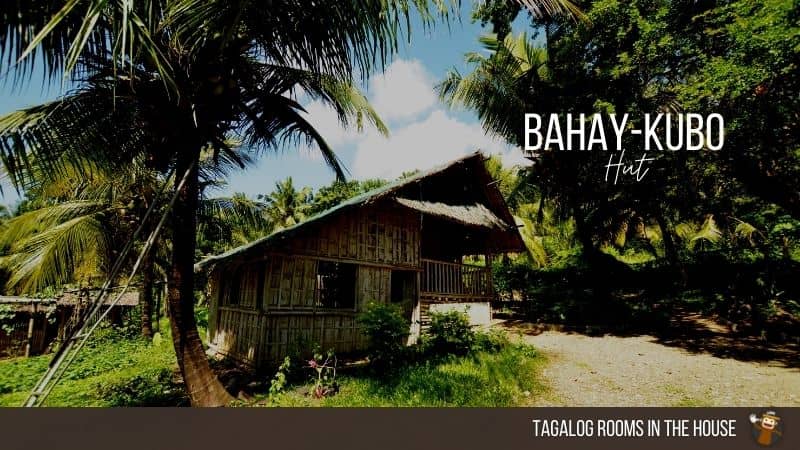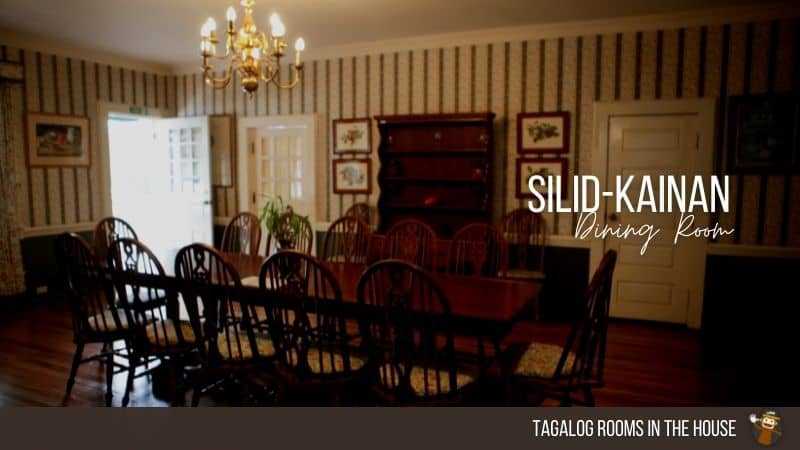Being invited to a Filipino house is truly an honor. It’s impossible not to feel warm and welcomed. Today, we will learn about basic Tagalog rooms in the house. If you are ready for that, keep reading below!
Filipinos are known to be very hospitable, and this value starts in the four corners of their house. For most Filipinos, every room in their house is important in their lives. This is not just about the basic use of these rooms but the memories being built and shared with their family.
In this blog, we will learn the basic rooms in the house in the Tagalog language. You will also learn some words related to each room with English translations to widen your vocabulary.
What’s The Tagalog Word For ‘Room’?
Before we learn the Tagalog rooms in the house, let us first learn how to say the word “room/s” in Tagalog.
The Tagalog/Filipino word for room is “silid.” It is the term used in textbooks and formal situations. You will see that in naming Tagalog rooms in the house, Filipinos usually use the word silid + the purpose of the room. One example is the word silid-tulugan, which came from the words silid (room) + tulog (sleep), so when you combine the words together, it means a room for sleeping.
If you’re in the Philippines, you’ll also hear people using “kuwarto,” which comes from the Spanish language. Filipinos prefer to use the word silid in school and other formal contexts because kuwarto is based on a foreign language.
For those new to learning the Filipino language, you should know that the Spanish colonized the Philippines for 333 years, so there is a huge influence of the Spanish language in their language.
Bahay-kubo – Hut
A typical Filipino house is the same as a house found in different countries. But, there is a traditional type of house in the Philippines called Bahay-kubo. This is a type of stilt house indigenous to the Philippines. It usually serves as an icon of the Philippines. Bahay-kubo doesn’t have all the rooms that a basic modern house has.

There are different parts of a bahay kubo – bubong (roof), silong (area under the living space), silid (living space), dingding (walls), durungawan (window), batalan (wet area), and kamalig (granary detached from the house).
Back then, bahay-kubo could be easily transferred from one place to another, and the interesting part of that is people were the ones who were lifting it. This imagery is usually used to portray Bayanihan, a spirit of unity and cooperation among Filipinos.
Before modern houses existed, Filipinos had Bahay-Kubo, which symbolizes their resilience, unity, and simplicity. This is proof that no matter how small it is, a house can still be called a home where individuals are molded with values.
Tagalog Rooms In The House
As foreign influences and modernization reached the country, the Philippines adopted the modern structure. In this part of the blog, we will name the different rooms in the house in the Tagalog language.
Sala – Living Room
Example Sentence: Ang sala ay ang lugar kung saan kami tumatanggap ng bisita. (The living room is where we receive our guests.)

The first room is the sala or sales. This is the living room where Filipinos entertain their guests. The living room is also the venue for different events like simple birthday parties, Bible studies, and pamamanhikan, a tradition where a groom’s family comes to the house of the bride’s family to ask for the bride’s hand formally. This is also where the family gathers together to watch TV shows, play, or bond with each other.
You’ll see a couch, TV, and a coffee table in a typical Filipino living room. You’ll see pictures hanging on their walls for the decorations, especially graduation pictures and family pictures. You can also see framed cross-stitches and paintings. As most of the country’s population is Catholic, some families also prefer to put their altar in the living room.
Indeed, the living room plays a big role in the development of a child inside the house and strengthens the bond of the family. Below are some of the words related to the living room.
- Bintana – Window
- Dingding – Wall
- Pinto – Door
- Sofa/Sopa – Couch
- Telebisyon – Television
- Mga larawan – Pictures
- Bisita – Visitor/Guest
Silid-tulugan – Bedroom
Example Sentence: Panatilihin mong malinis and iyong silid-tulugan.(Keep your bedroom clean.)

The word silid-tulugan is made of two words silid (room) and tulugan (a place to sleep). Filipinos also use kuwarto to refer to the bedroom.
Unlike in western families, typical Filipinos don’t have one bedroom or silid-tulugan for each family member. Usually, children of the same gender share the same room while their parents have a separate room. Some families cannot afford a house with a room, so they all sleep together in one room. But wealthy families or those families who can afford it have their own rooms.
Here are some Tagalog words related to the bedroom:

Kusina – Kitchen
Example Sentence: Magluluto ako ng pagkain sa kusina.– (I will cook food in the kitchen.)
The kitchen or kusina is one of the mostly-used rooms in the house. It is also influenced by the Spanish word la cocina, which means kitchen. It is undeniable that Filipinos love to cook, and when we talk about Filipino food, it’s sure that it is mouthwatering. Cooking in a Filipino kitchen is also a bonding time for the family, especially when there’s a big celebration.
The dirty kitchen is usually located at the back of the house, but not all Filipino houses have a dirty kitchen. In rural areas, people cook outside or in their backyards with a really huge flat cooking pot and fire, especially for big celebrations like weddings and birthday parties. When you are a Filipino, or you have a Filipino relative, you can clearly imagine what I mean.
Here are the Tagalog words related to kitchen or kusina:
- Abrelata/Pambukas – Can Opener
- Itak – Bolo
- Gripo – Faucet
- Kalan – Stove
- Kaldero – Pot
- Kawali – Pan/Frying pan
- Kutsilyo – Knife
- Luto – Cook
- Pugon – Oven
- Ref/Pridyder – Refrigerator
- Salaan – Colander/ Strainer
- Sangkalan – Chopping board
- Sandok – Laddle/ Big scoop
- Takure – Kettle
Silid-kainan – Dining Room
Example Sentence: Masayang kumakain and buong pamilya sa silid-kainan. (The whole family is happily eating in the dining room.)

The word silid-kainan also came from the two words silid (room) + kain (eat). A typical Filipino Catholic dining room has a picture of the Last Supper in their dining room. The dining table is usually a rectangle where the head of the family sits on the kabisera or the ends of a table. If the table is round, the head of the family sits wherever they want to sit.
For Filipinos, food is not just about eating and nourishing your body. It is also about the moments that people share over the food, and the dining room or silid-kainan is a huge part of it. Eating together as a family is a strong tradition in the Philippines. There’s a famous quote that says, “The family that eats together, stays together.”.
Below are the words related to the dining room in Tagalog.
- Baso – Glass
- Cup – Tasa
- Kain – Eat
- Kutsarita – Teaspoon
- Kutsara – Spoon
- Mangkok – Bowl
- Mantel – Table cloth
- Mesa/Lamesa – Table
- Plato – Plate
- Platito – Saucer
- Serbilyeta – Table napkin
- Tinidor – Fork
Palikuran – Bathroom
Example Sentence: Nasaan and palikuran? – (Where’s the bathroom/comfort room?)

Another important room in the house that you should learn about is the bathroom or palikuran. The word palikuran has a fascinating background. Back then, the comfort room in a typical Filipino house is located at the back (likod) of their home. This is where the name palikuran is derived from.

Traditional Filipino houses don’t have bathtubs. They use a pail and dipper, which is not common in other western countries. If you find a big rock in a Filipino house, do not be shocked or confused because they actually use it as a scrub to remove dirt from your body.
Below are the Tagalog words related to palikuran:
- Inidoro – Toilet bowl
- Ligo – Bath
- Panghilod – Loofah/Scrub
- Sabon – Soap
- Salamin – Mirror
- Sipilyo – Toothbrush
- Tabo – Dipper
- Timba – Pail
- Tisyu – Tissue
- Toothpaste – Toothpaste
- Tubig – Water
- Tuwalya – Bath towel
Labahan – Laundry Room
Example Sentence: Si nanay ay naglalaba sa labahan. (Mom is doing laundry in the laundry room.)

One interesting thing about traditional Filipinos is that they used to ash their clothes in rivers with soap and palo-palo, a wooden laundry hammer. They also used to wash their clothes with a palanggana (basin) and pail in their backyard. They have this thing called poso, a type of water well. After they finish their laundry, they will hang it outside. In short, traditional Filipino houses do not have a laundry room. It is only in modern times that people build laundry rooms in their houses, mostly wealthy ones.

Below are the Tagalog words related to the laundry room:
- Damit – Clothes
- Laba – Washing of clothes/Doing Laundry
- Labahin – Dirty Clothes/Laundry
- Palanggana – Basin
- Sampayan – Clothesline
Other Tagalog Rooms In The House
- Bodega – Storage Room
- Balkonahe – Balcony
- Basement – Basement
- Garahe – Garage
- Pasilyo – Hallway
- Hardin – Garden
Bored In Your Room? Learn Tagalog With Ling App Now!

If you find yourself just sitting in your sala or silid-tulugan doing nothing, why not try to search the Ling App website or download the app and start learning Tagalog. The Ling App is a platform that allows learners to study a certain language in a fun and convenient way.
First, you can choose a topic or content that suits your interests. Then you’ll encounter a series of learning activities that will develop your language skills. You won’t have to worry about the effectiveness because this platform is developed by language experts and native speakers, plus the data, ads, and reviews about the app do not lie.
Discovering Ling App is not an accident. It is a sign that you need to improve your language skills with Ling App now. With all the language services online, Ling App is truly worthy. Try it out now!


















